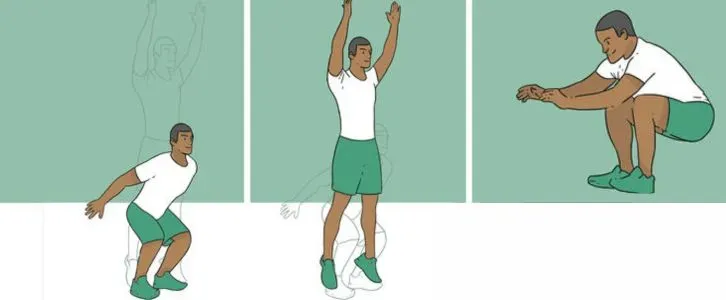
How to Increase Vertical Jump
How to Increase Vertical Jump
A high vertical jump is a game-changer for basketball players, volleyball athletes, and track & field competitors. Whether you want to dunk like an NBA pro, spike harder in volleyball, or improve your explosiveness, training your vertical jump can boost your performance across multiple sports.
In this guide, we’ll break down the science behind jumping, top exercises, training techniques, and nutrition tips to help you gain 5+ inches on your vertical in just a few weeks.
Vertical Jump & How It Works
Vertical Jump & How It Works

🏀 What is a Vertical Jump?
A vertical jump measures how high you can leap off the ground from a standing position. It’s used in basketball, volleyball, football, and track & field as a key indicator of explosiveness and lower-body power.
🔥 Why Is It Important for Athletes?
✔ Basketball: Dunking, rebounding, and blocking shots
✔ Volleyball: Spiking, serving, and defensive play at the net
✔ Track & Field: High jump, long jump, and sprinting explosiveness
🧪 The Science Behind Jumping Higher
Your vertical jump depends on:
✅ Leg & Core Strength – Stronger muscles generate more force
✅ Fast-Twitch Muscle Fibers – These fibers fire quickly for explosive movement
✅ Momentum & Technique – Proper form increases jump height
✅ Flexibility & Mobility – Looser joints allow a greater range of motion
📌 Key Takeaway: A higher jump isn’t just about strength—it’s about power, speed, and coordination.
Factors That Affect Your Vertical Leap
Factors That Affect Your Vertical Leap

⚡ Strength & Power Generation
✅ More leg strength = More force against the ground = Higher jump
✅ Explosive training builds power faster than just weightlifting
💥 Fast-Twitch vs. Slow-Twitch Muscle Fibers
✅ Fast-Twitch Fibers (Type II): Help with explosive, quick movements (essential for jumping)
✅ Slow-Twitch Fibers (Type I): Good for endurance but not for jumping
📌 Athletes with higher fast-twitch activation have a natural advantage in vertical leap.
🚀 Explosiveness & Reaction Time
✅ Quick ground contact time = higher jumps ✅ Training reaction speed helps you jump faster & higher
🤸♂️ Flexibility & Mobility
Tight hamstrings, ankles, or hips = limited jump height Dynamic stretching & mobility drills improve range of motion
📏 Proper Technique & Biomechanics
✅ Jumping form matters!
✅ Using arms correctly, bending knees at the right angle, and landing softly prevents injury and boosts height
📌 Key Takeaway: Improving technique, mobility, and explosiveness leads to faster gains in your vertical jump.
How to Gain 5 Inches of Vertical Jump in 3 Weeks
How to Gain 5 Inches of Vertical Jump in 3 Weeks

⏳ Is It Possible?
While 5 inches in 3 weeks is aggressive , consistent training and proper technique can lead to noticeable improvements in a short time.
📌 Training Principles for Fast Vertical Gains
✅ Train explosively – Focus on max effort jumps
✅ Lift heavy weights – Strength directly impacts jump height
✅ Improve mobility – Stretching increases jump range
✅ Recovery is key – Overtraining leads to fatigue & slower progress
🚨 Warning: Don’t expect instant results without putting in the work— consistency and recovery are just as important as workouts.
Drills to Increase Vertical Jump to Become More Explosive
Drills to Increase Vertical Jump to Become More Explosive

🦘 Jump Technique Drills
🦘 Jump Technique Drills
- Focus on arm swing, knee drive, and landing position
- Keep core tight and avoid excess movement
🔥 Fast-Twitch Activation Drills
🔥 Fast-Twitch Activation Drills
- Speed jumps with minimal ground contact
- Reaction drills to improve jump timing
🏋️ Isometric Holds & Resistance Training
🏋️ Isometric Holds & Resistance Training
- Resistance bands & weighted jumps improve force output
- Isometric holds (wall sits, squat holds) build endurance for jumping
📌 Drills train your body to react faster and explode off the ground.
How to Increase Your Vertical Jump for Basketball at Home
How to Increase Your Vertical Jump for Basketball at Home

🏠 No Gym? No Problem!
🏠 No Gym? No Problem!
✔ Jump Squats & Bulgarian Split Squats – Build leg strength
✔ Broad Jumps & Box Jumps – Train explosion at home
✔ Resistance Band Training – Mimics weighted resistance
📆 Daily Routine for Steady Improvement
📆 Daily Routine for Steady Improvement
Morning: Mobility & flexibility work
Afternoon: Strength & explosive exercises
Evening: Jump drills & recovery
📌 Consistency is key—even without a gym, you can see massive improvements.
Nutrition & Recovery for a Higher Vertical Jump
Nutrition & Recovery for a Higher Vertical Jump

🥩 Foods That Fuel Explosiveness
🥩 Foods That Fuel Explosiveness
✔ Protein – Chicken, eggs, fish, lean beef
✔ Complex Carbs – Oats, brown rice, sweet potatoes
✔ Healthy Fats – Avocados, nuts, olive oil
😴 Sleep & Recovery
😴 Sleep & Recovery
✔ Aim for 7-9 hours of sleep – Rest is when muscles grow
✔ Stretch daily – Reduces injury risk & improves mobility
📌 Nutrition + Sleep = Faster Jump Gains
How to Track Progress & Keep Improving
How to Track Progress & Keep Improving

📏 How to Test Your Vertical Jump Correctly
📏 How to Test Your Vertical Jump Correctly
✔ Use a chalk or Vertec to track improvement
✔ Measure before and after workouts to see progress
📆 Adjusting Workouts Based on Results
📆 Adjusting Workouts Based on Results
✔ Stagnating? Increase weight or volume
✔ Overtraining? Take a rest week to recover
🏆 How Often Should You Train?
🏆 How Often Should You Train?
📌 3-4x per week is ideal—avoid daily high-intensity jump training to prevent overtraining.
Conclusion: Your Path to a Higher Vertical Jump
Conclusion: Your Path to a Higher Vertical Jump
✔ Jump higher by combining strength, explosive drills, and mobility training
✔ Nutrition, recovery, and consistency are key to maximizing gains
✔ Track progress & adjust training to keep improving
🚀 Follow this guide, and you’ll see major improvements in your vertical leap!
📲 Want More Training Tips? Download Our App!


